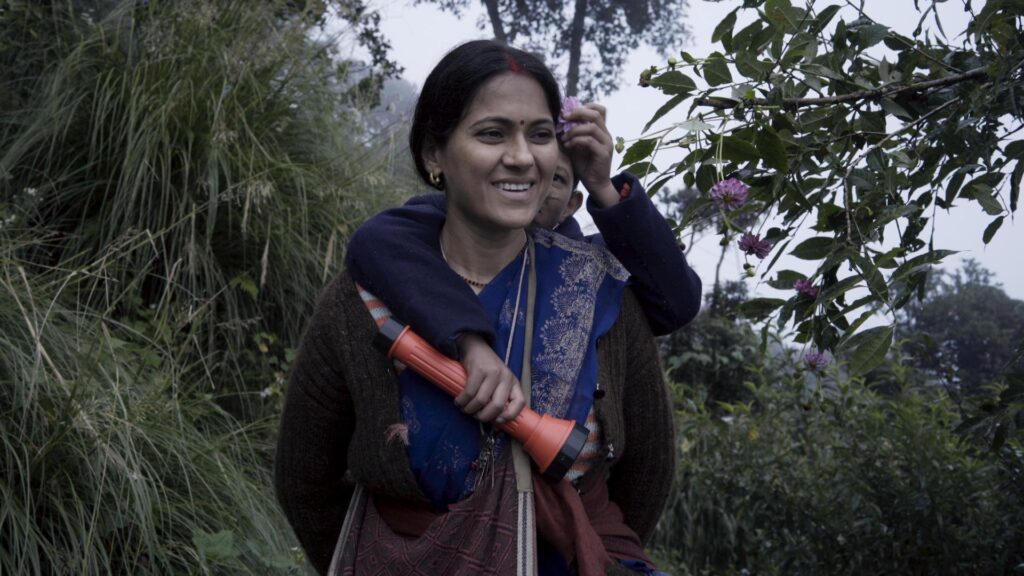After an extremely successful run on the festival circuit, Ajitpal Singh’s debut feature, Fire In The Mountains (2021), is finally streaming on Sony LIV. The film marks an assured enough debut for Singh and reiterates once again how far Indian Indie cinema has come today. That said, for all its highs, the film is solid but just falls short of ‘being there’.
Fire In The Mountains unfolds in a village located in the Munsiyari region of Uttarakhand. Chandra (Vinamrata Rai) is a hard-working woman, who does the daily chores of her family in addition to running a small homestay for tourists. Her husband, Dharam (Chandan Bist), a habitual drunkard, has failed in almost every aspect of his life. Other members of her family include her widowed sister-in-law, Kamla (Sonal Jha), who helps her with household activities, her teenage daughter, Kanchan (Harshita Tiwari), who is obsessed with uploading her videos online to garner likes, and young son, Prakash (Mayank Singh Jaira), who has lost his capacity to walk following an unfortunate accident. Chandra saves as much money as she can to take Prakash to the city for treatment from a physiotherapist. Looking at the misfortune that has befallen the family, Dharam is convinced their family deity is unhappy with them and often visits an occultist, who convinces him to perform a shamanic ritual, ‘jagar’, for the betterment of his family. Dharam asks Chandra to give her savings to him for performing these rituals. She refuses thereby leading to a conflict between her and Chandan that threatens to break the harmony of the family…
The film effectively explores the complexities and inner workings of a family and how the relationships between various family members suffer as a result of their ideologies and conflicts. The characters are trapped in poverty and circumstances by a society that least cares about them. Singh constructs the film delicately within a harshly realistic framework and without a whiff of any melodrama whatsoever. He keeps the film going at a languid rate, aiming to capture the day-to-day rhythm of life of his characters.
The narrative of the film unfolds primarily through the trials and tribulations of Chandra. Despite being subjected to repeated humiliations and exploitation by the deeply ingrained patriarchal entitlements of the men around her, she never loses her spirit. Within the very first few minutes of the film, we observe her carrying Prakash piggyback. This act, shown repeatedly through the film, becomes a metaphor for the burden on her to keep her family happy. At the same time, she is also sympathetic towards her good-for-nothing and, at times, even abusive husband. Through Kanchan, a sharp young girl stepping into womanhood and becoming aware of her sexual desires and Chandra, the film becomes a critical examination of the conflict not just between generations but also between a society embracing modernity versus its ancient traditional values. Just like the development of the Munsiyari region remains neglected under the purview of the government, Chandra’s efforts to keep her family together are never acknowledged by anyone in her family.
Despite his visionary and out-of-the-box treatment, Singh uses the scenes to clinically move the story forward rather than letting us live with his characters. The film needed more scenes such as the one where the son, Prakash, puts a flower on Chandra’s bun or the one in the school field involving Chandra, Dharam, Prakash and the principal. Moreover, the character of Dharam is a rather unidimensional one making it difficult for us to invest in him.
Vinamrata Rai’s combative, unsentimental performance makes Chandra’s slow ruin not just credible but heartbreakingly unavoidable. She remarkably conveys a range of emotions – uncertainty, vulnerability, helplessness, determination, and courage – with the ease of a seasoned artist. Chandan Bist, despite his sketchy role, convincingly brings out his own demons even as he struggles with his moral dilemmas. They are well supported by Mayank Singh Jaira and Harshita Tiwari, who as Kanchan, brings out the youthful vibrancy of her characters, shining in the more emotional moments of the film as well. Sonal Jha does not have much screen time but nevertheless manages to do full justice to her role as a widow having to live under the care of Dharam and Chandra.
On the technical side, Dominique Colin’s lens captures the rural, hilly landscape of Uttarakhand with a reality and harshness without being exotic or picture postcard-like. What’s more, he sensitively frames the characters in their moments of crisis, allowing viewers to make their own interpretations. The deft editing by Parikshhit Jha and Simon Price’s helps the film flow smoothly from the beginning to the end while convincingly maintaining the rhythm of everyday life through its unhurried pace. Mausam Aggarwal’s minimalist production design and Karishma Vyas’s simple yet evocative costumes enhance the realistic appeal of the film. The background score by Arnaud van Vliet creates an inherent sense of foreboding that lingers over the narrative.
No doubt, Fire In The Mountains has much going for it and makes Singh a filmmaker to look out for. Overall, it is a fine effort and works well for most of its entirety. Which is more than you can say for most films these days.
Hindi, Drama, Color


